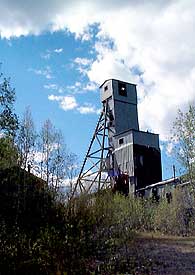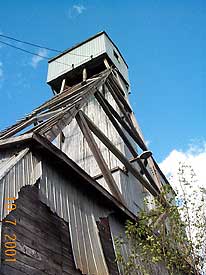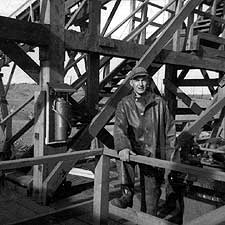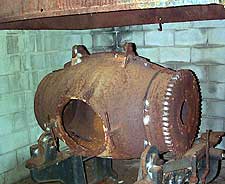|
|
|
 |
We stood inside the abandoned headframe at the former Sapawe Gold Mine. The wind moaned gently through the holes in the walls and the roof. Old wood creaked and popped. Just like out at the Steep Rock property, we were standing in a place that once buzzed with human activity that has long since departed. It is easy to understand the appeal of ghost towns. Visiting places that were busy long ago and are now quiet demands that we humans ruminate on how impermanent some of our activities, especially the extractive ones are. |
 |
Bill Beyer, long-time board member of the Mining Attraction suggested the "field trip". Heather Schmutzer, Chair of the board, Amanda James, the summer student at the Mining Attraction and me, the manager enthusiastically agreed. Amanda was particularly excited at the prospect. She has visited the site many times before and enjoys poking about in vacant buildings. Apparently, her dad, who has worked in the mines, introduced her to this "hobby" when she was young. With her sharp eyes and intense curiosity, she added a lot of youthful energy to the trip. Me, more cautious, I concentrated on taking photographs.
The headframe brought back visual memories of a childhood spent in the gold-mining town of Timmins. At the top of the headframe., a couple of large owls had made their home. They expressed their displeasure at our intrusion as they flew away. Large machinery remains inside the buildings. Bill could tell us the names and functions of them. He worked at the mine when it was in operation . |
 Jack Kosola, carpenter at the mine photo donated to the AMAA by Jack Kosola |
Here are a few facts that turned up with some light research work: – 1895-1910: the area was being actively prospected and the vein was discovered; – 1929: some exploratory work was done – 1945: nine holes were drilled by E. Corrigan – 1960: further diamond drilling was done by Lindsay Explorations – 1963: the property was acquired by Sapawe Gold Mine and a mill, with a capacity to treat 100 tons of ore per day was built. Statistics from the Ontario Dept. of Mines: 1964: 2671 ounces of gold and 694 oz. of silver valued at $101,800.00 was produced 1965: 289 oz of gold and 58 oz. of silver, valuing $10,985.00 1966: 1587 oz of gold and 563 oz. of silver valuing $60,634.00 Totals for the three years: gold: 4547 oz., silver 1315 oz. for a total value of $173,420.00 |
 |
In 1969, the company was unable to raise the necessary funds to put the Atikokan property back into production.
Now, all that is left is ghosts and remnants, memories of a more productive time. The owls have found a home there. I have been told that there continues to be speculation and test drilling on the site – awaiting perhaps, an economical reason to bring some activity back to the site. |
|
|